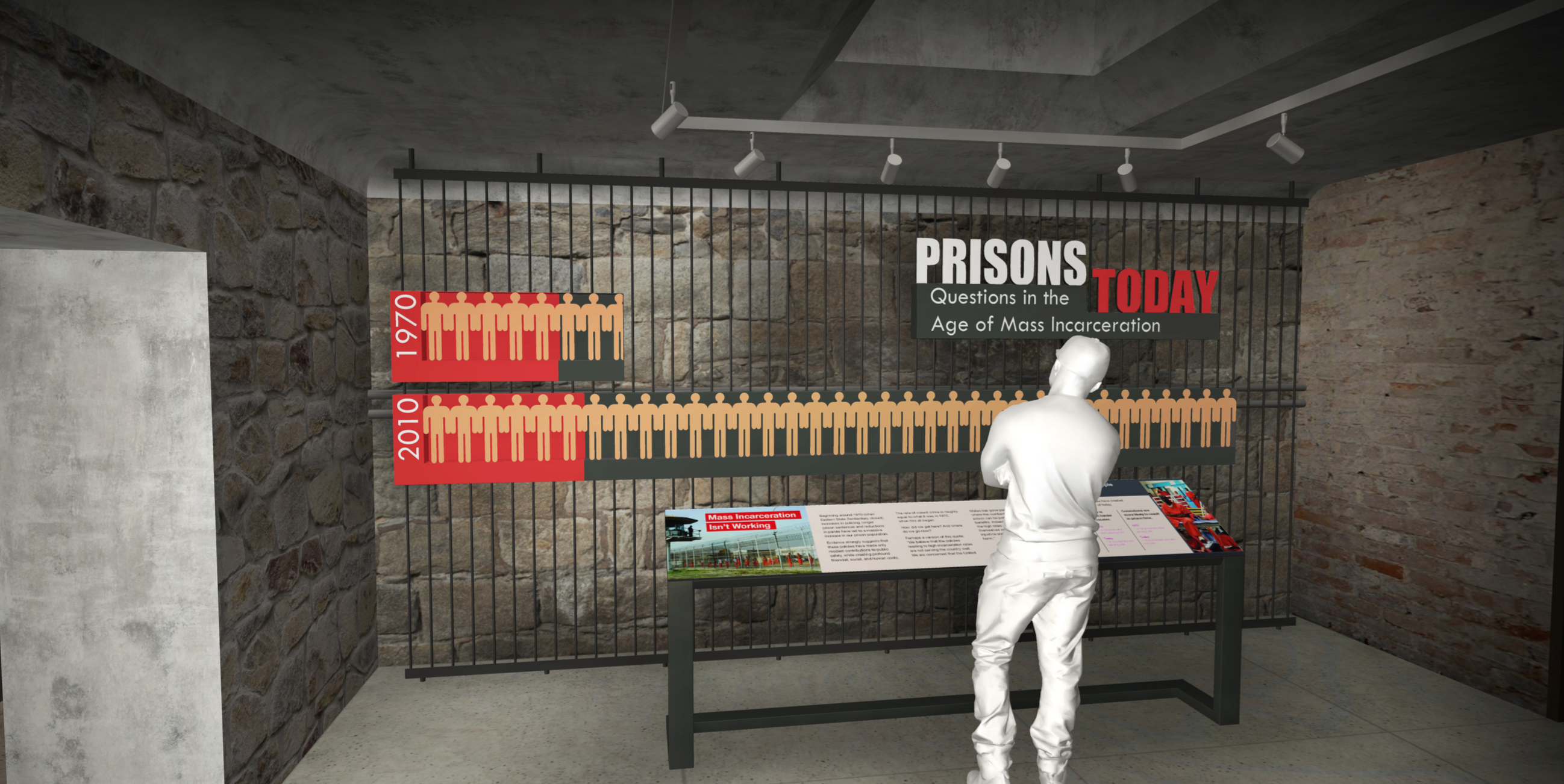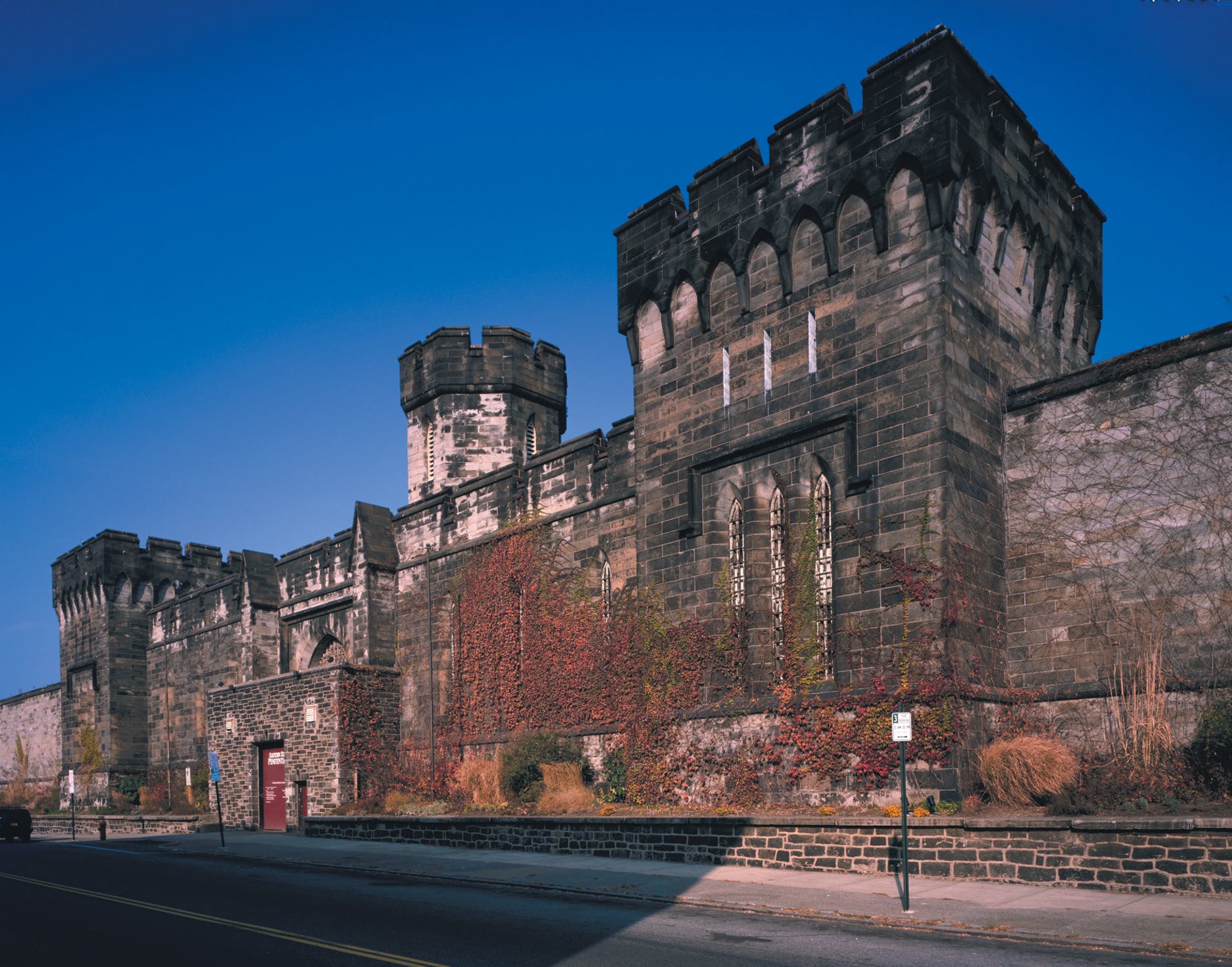
Tough questions in an exhibit at Philadelphia’s Eastern State Penitentiary
Near the back of the grounds at Eastern State Pentitentiary–Philadelphia’s historic 19th-century prison complex turned museum–visitors can find its newest structure, a 16-foot tall tower that serves as the dubious pinnacle of its so-called “Big Graph.” Instead of looking to the sometimes distant past, as many of Eastern State’s displays do, this bar graph focuses on the present and future of the prison system, acting as a focal point for an expansive exhibit: “Prisons Today: Questions in the Age of Mass Incarceration.”
Although the installation provides a range of information about the United States prison population in comparison to other countries, the elephant in the room is undoubtedly the staggering jump in height across its final five columns. The 600 percent increase in Americans behind bars between 1970 and 2010 is illustrated with devastating effect at this scale, as are the prisons’ racial disparities and steep climb in population despite fluctuations in actual crime rates. All of the data, in the shadow of this looming metal structure, tells the story of a social tool that has not only outgrown its utility, but has come to represent an injustice itself; an institution that has mutated into the very problem it aims to address.

With the knowledge that the United States imprisons more of its citizens, by far, than any country on earth (the U.S. currently incarcerates 730 people per 100,000, effectively crushing even the second place Rwanda, which clocks in at 527), visitors may step inside the Eastern State Penitentiary complex in order to face these facts with considerably more detail.
“There is now bipartisan agreement that the U.S. incarcerates too many people,” says Sean Kelley, senior vice president and director of interpretation and public programming at Eastern State Penitentiary, “We titled that first graph ‘Mass Incarceration Isn’t Working’ to make it clear that the real questions revolve around what our nation should do now.”
Directly to the right-hand side of the entrance, the “Prisons Today” exhibit begins with a multi-screen video by Greenhouse Media playing on a loop every few minutes. Beginning in the late 1960s, the documentary-style movie traces the sociopolitical steps that led to this country’s massive prison expansion over the past few decades. As highlights from legislators and presidents speaking about the scourge of drugs or pitching their ‘tough on crime’ policies to the masses play on, informational texts and dates offer viewers historical context. All the while, the prison population ticks ever higher in relation to the date, eventually surpassing two million individuals just after the turn of the 21st century.
From here, the display begins to take an interactive turn, directly posing questions to visitors and offering hands-on activities that seek to better inform us about incarcerated life and those who spend a portion of their lives behind bars. “You’re very unusual,” reads one of the first red signs past the video. “About 70 percent of American adults have committed a crime that could lead to prison. Most of us will never experience arrest, trial or prison. Why is that?” Written statements by visitors to Eastern State, paired with accounts by actual inmates, detail laws broken and damage done, sometimes accompanied by an admission of remorse. By pressing a button, red lights designate the stories by those in prison or not, and the results are often shocking.

Elsewhere, visitors may also examine the role of the death penalty, see belongings and hear stories from inmates, and assess their own likelihood of being locked up based on their education, economic standing and race. The section “What Are Prisons For?” addresses the four main goals of correctional facilities, including retribution, deterrence, rehabilitation and incapacitation, as well as the effectiveness of these values and potential ulterior motives such as profit.
“Prisons Today” manages to ask the tough questions, while unfortunately offering very few answers. If there were easy solutions, however, perhaps we wouldn’t be forced to gaze up at the 16-foot monolith that stands in for the grim realities so frequently locked out of sight. Knowledge, as they say, is power, and without facing the hard facts of America’s prison epidemic that continues to wreak havoc on poor, minority communities and nonviolent criminals, there will likely be no possibility of slowing this runaway trend. Next to the tallest column in the “Big Graph,” there is a humble plaque that holds the place for the expansion of the installation in 2020. It asks simply, “How would you like to see the U.S. prison system change?” Although this gesture is small, it challenges us all to consider a new way forward, which is undoubtedly what we need.
Eastern State Pentitentiary is located at 2027 Fairmount Ave., Philadelphia.
Recent Content
-
Artsarticle ·
-
Artsarticle ·
-
Artsarticle ·

